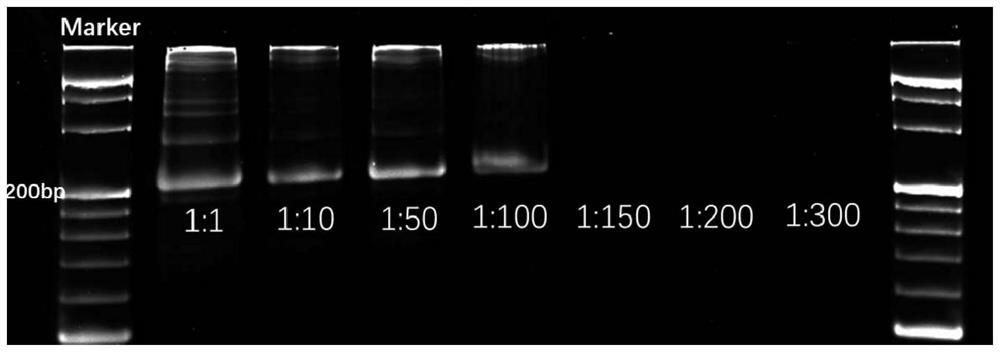Compound for preventing osteonecrosis and/or promoting angiogenesis and pharmaceutical application thereof
A compound and drug technology, applied in the field of biomedicine, can solve problems such as limited effects and failure to meet clinical needs, and achieve the effects of promoting proliferation and migration, good application prospects, and promoting angiogenesis
- Summary
- Abstract
- Description
- Claims
- Application Information
AI Technical Summary
Problems solved by technology
Method used
Image
Examples
Embodiment 1
[0035] Example 1. Synthesis of the complex of tFNA and KLT polypeptide (tFNA-KLT)
[0036] refer to figure 1 As shown in the schematic diagram, the complex tFNA-KLT of tFNA and KLT is synthesized, and the specific steps are as follows:
[0037] (1) Synthesis of tFNA
[0038] The four DNA single strands (S1, S2, S3, S4) were dissolved in TM buffer (10 mM Tris-HCl, 50 mM MgCl 2 , pH=8.0), control the final concentration of the four DNA single strands to 1000nM, mix well, rapidly heat to 95°C for 10 minutes, and then rapidly cool down to 4°C for 20 minutes to obtain DNA tetrahedral framework nucleic acid: tFNA.
[0039] (2) Synthesis of complex tFNA-KLT
[0040] Then, according to the molar ratio of tFNA:KLT=1:100, tFN and KLT were co-incubated at room temperature for 30 min to obtain a complex of tFNA and KLT polypeptide: tFNA-KLT.
[0041] The sequence of the four single-stranded DNA (5'→3') is as follows:
[0042] S1:
[0043] ATTTATCACCCGCCATAGTAGACGTATCACCAGGCAGTTGAGACGA...
experiment example 1
[0053] Experimental example 1. Screening experiment of the ratio of tFNA and KLT
[0054] 1. Experimental method
[0055] The complex of tFNA and KLT was prepared by referring to the method of Example 1, the only difference being that the molar ratio of tFNA:KLT in the control step (2) was 1:1, 1:10, 1:50, 1:100, 1:150, respectively , 1:200, 1:300. The complexes of tFNA:KLT co-incubated with different molar ratios were obtained.
[0056] Identification: The complexes obtained after co-incubating tFNA and KLT with different molar ratios were detected by PAGE electrophoresis; the shape of tFNA-KLT was detected by atomic force microscopy; the zeta potential and particle size of tFNA-KLT were detected by dynamic light scattering.
[0057] 2. Experimental results
[0058] like figure 2 As shown, the electrophoresis results showed that when the molar ratio of tFNA:KLT was 1:100, the maximum ratio of tFNA loaded with KLT was reached, so the optimal molar ratio of tFNA and KLT co...
experiment example 2
[0060] Experimental example 2. Uptake of tFNA-KLT by human umbilical vein endothelial cells (HUVEC)
[0061] 1. Experimental method
[0062] FAM (6-carboxyfluorescein)-modified KLT and tFNA-KLT were mixed in the cell culture medium at a concentration of 250 nm, and then cultured for 6 h. To take images, HUVECs were washed with phosphate buffered saline (PBS) and fixed with 4% paraformaldehyde. Cytoskeleton was stained with phalloidin and nuclei were stained with DAPI.
[0063] The tFNA-KLT used in this experimental example was prepared in Example 1.
[0064] 2. Experimental results
[0065] like Figure 4 As shown, the results of immunofluorescence staining showed that both tFNA-KLT and KLT were taken up by HUVECs at 6 h; compared with KLT, the uptake effect of tFNA-KLT was better.
PUM
| Property | Measurement | Unit |
|---|---|---|
| weight | aaaaa | aaaaa |
Abstract
Description
Claims
Application Information
 Login to View More
Login to View More - R&D
- Intellectual Property
- Life Sciences
- Materials
- Tech Scout
- Unparalleled Data Quality
- Higher Quality Content
- 60% Fewer Hallucinations
Browse by: Latest US Patents, China's latest patents, Technical Efficacy Thesaurus, Application Domain, Technology Topic, Popular Technical Reports.
© 2025 PatSnap. All rights reserved.Legal|Privacy policy|Modern Slavery Act Transparency Statement|Sitemap|About US| Contact US: help@patsnap.com



